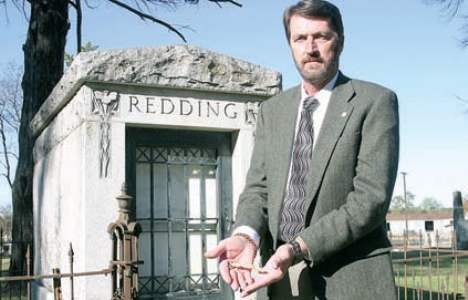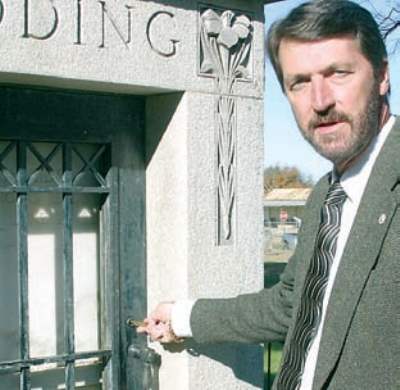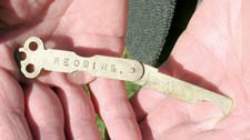




Milam County Historical Commission
Milam County, Texas
Milam County, Texas

Tale From The Crypt
Mausoleum key found but many mysteries stay
By MIKE BROWN - Reporter Editor
Rockdale reporter - December 4, 2014
The key — literally — to one of Rockdale’s oldest mysteries has been discovered, but in
some ways it only deepens the puzzle.
Phillips & Luckey Funeral Home has located the key to the Redding Crypt, the mausoleum
that dominates the Old City Cemetery on South Main Street. It’s a structure that has
puzzled Rockdale residents for perhaps 80 years.
It goes to a metal door, which once contained a pane of glass, that’s incorporated into
an imposing marble and granite structure containing the remains of a woman who died 86
years ago.
The door leads only to a solid marble slab.
Its inscription identifies the mausoleum as the final resting place of Alpha Louise
“Ludie” Redding, who lived from 1854 to 1928.
The tomb was named one of Milam County’s “seven wonders” by The Reporter in a tongue-in-
cheek series published in the 2012 FYI visitor’s guide.
“Is there actually a key?” that story asked.
The answer is “yes” but that’s about the only answer we’ve got on the Redding Crypt.
VOLUNTEER — The revelation was triggered when volunteer Jack Brooks, who spearheaded a
huge project to clean up and restore Rockdale’s oldest cemetery, had the idea to replace
the pane of glass in the mysterious door.
He went to Phillips & Luckey, which has provided mortuary services for Rockdale since the
1930s.
Brooks was literally being advised the longtime business had no idea where the key was
when funeral home employee Stephen Jones spoke up.
“I told him I thought I remembered seeing an old key back somewhere in storage,” Jones
said. “I used to be in the old building as a kid and I was pretty sure a lot of that
stuff was brought over to the new building and we still had it somewhere.”
A search hit the jackpot.
A thin, brass-colored, “switchblade” style key was found. “I’d never seen a key like
that,” Jones said.
The word “Redding” was engraved on the front—if a key has a front—with the name of the
manufacturer on the back: Sargent and Greenleaf, Rochester, New York.
That firm is still in business and The Reporter contacted Brian Costley, S&G director of
training, at the company’s headquarters in Nicholasville, Kentucky.
He’s a collector and historian. “It’s interesting to hear one of S&G’s old mausoleum
locks showed up in Texas,” he said. “Most seem to have been used in cemeteries in New
York and New England.”
Costley has a model of the old mausoleum lock and a couple of the uncut “folding keys” in
his collection. “They are prized as collector’s items,” he said.
TOO OLD — “I don’t know why we have the key” Jones said. “It could have been part of the
items Phillips & Luckey inherited from the previous funeral directors or it could have
been brought to us by a family member over the years.”
“It’s just such a long, long time ago that nobody knows,” he said.
Did they try to open the door? Of course they did.
The key doesn’t work.
“The mechanism is so old you really can’t even get the key in,” Jones said. “And even if
you could, the handle, which is part of the unlocking mechanism, is broken and it won’t
turn.”
That leaves the cemetery volunteers back where they started. “They’re going to have to
get the door open somehow to replace the pane of glass,” Jones said.
WHY! — Finding the key, of course, still doesn’t solve the main mystery of the Redding
Crypt. Why is there a door to nowhere? Jones, looking at the tomb with a professional
eye, provides a possible answer.
“From the way the marble behind the door is designed it’s obvious this mausoleum was
constructed so a second person could be interred,” he said.
(It wouldn’t be Mrs. Redding’s husband. John Nicholas Redding preceded his wife in death
by 41 years and is buried, underground, in the same plot.)
Jones theorized the door would provide a way to access the inner tomb to bury another
person.
But. It really doesn’t. “You’d still have to break in,” Jones said. “You would have to
get behind that solid marble wall somehow.”
More Mystery - There are still more questions.
“You know, she died in 1928 but this thing wasn’t built in a couple of weeks after she
died,” Jones said. “This was a huge and expensive task. It had to have been built well in
advance. There’s isn’t any telling how much it would cost to duplicate today.”
While many headstones in the old cemetery much newer than the Redding Crypt’s granite are
showing signs of wear and age, it looks virtually new and sparkles in the sunlight.
And the door? “I don’t even know what kind of metal it is,” Jones said. “It’s not iron.
It hardly has any rust on it and the thing is at least 86 years old.”
LANDMARK — The crypt actually is something of a local landmark, not in the least because
it’s so imposing a structure.
“People don’t believe we have a mausoleum until they see this,” Jones said. “Obviously,
it’s not easy to miss.”
Now what? Will we ever know all the ‘whys’ behind Ludie Redding’s imposing resting place?
“It’s probably unlikely,” Jones said. “About the only way I’d ever see that happening
would be if somebody in the family — if there’s still anyone left who knows — should see
this some day and contact someone in Rockdale.”
Jones pauses at the cemetery gate and looks back.
“The problem is time,” he said. “Everyone buried in here, it was just a long time ago
when they lived. There’s so much history in there that we’re never going to know.”
All Credit for this article
goes to Mike Brown
and the
Rockdale Reporter
goes to Mike Brown
and the
Rockdale Reporter



Phillips & Luckey’s Stephen Jones shows the key which deepens one of Rockdale’s longest standing mysteries.
Right: Jones tried to open door but the (at least) 86-year old lock wouldn’t cooperate. The handle is broken, too.
.
.
.